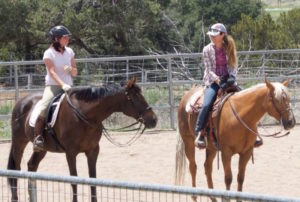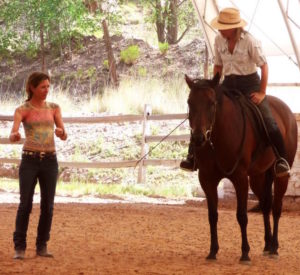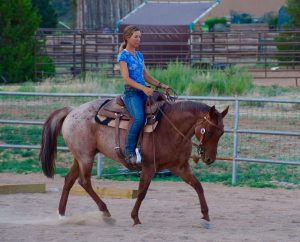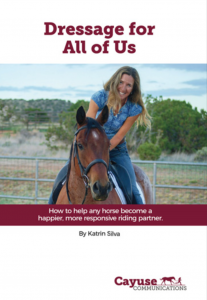Editor’s Note: Best Horse Practices Summit presenter Katrin Silva grew up riding dressage in Germany before moving to the United States at age 19 to learn to ride Western. She’s been riding both disciplines for the last twenty years and is a regular guest columnist for Cayuse Communications. She lives in New Mexico where she works with dressage and Western clients. Visit her blog here.
Buy her book, Dressage for All of Us here.
Katrin writes:
 My new student rides a lovely quarter horse gelding. The two of them have been a pair for years. On the trail, they get along fine, in spite of occasional disagreements about speed or direction.
My new student rides a lovely quarter horse gelding. The two of them have been a pair for years. On the trail, they get along fine, in spite of occasional disagreements about speed or direction.
In the arena, they struggle. During a lesson yesterday, my student complained that her horse was unresponsive and lazy.
“He just doesn’t like arena work!” she complained.
I asked her to show me what she was doing to make him more responsive. She squeezed harder and harder with her legs. She dug her heels deeper and deeper into his sides. Instead of moving faster, he ignored the progressively harsher aids. As my student worked herself into exhaustion, his trot became more and more sluggish instead of lofty and elastic. My student, who loves her horse, tried to contain her frustration.
“He’s purposely ignoring me!” She muttered, as her horse slowed to a crawl. She looked as aggrieved as my mother looked when I was a teenager. The horse looked like me when lectured about the dangers of everything I found cool. He was giving his rider the massive eye roll. She was giving him the “I-know-what’s-best-for-you-but-you-won’t-listen!” death stare.
It was time to intervene, before either horse or rider stormed out of the arena (figuratively slamming the door like I used to when I was fifteen). I asked my student to shift her focus:

Silva teaches in and around Santa Fe, NM. A pre-pandemic moment
“Take your leg off,” I told her.
“But he has not responded yet!” she argued.
“It doesn’t matter. Take it off.”
She did. The horse stopped dead.
“Now, nudge him with your leg, just a little tiny bit. If nothing happens, repeat once, then do whatever it takes to make him move. And then, as soon as he starts moving, or even thinks about moving, take your leg off again.”
My student looked doubtful, but decided to give it a try. She nudged the horse, then tapped him a couple of times with her whip. The horse kicked out, shook his head, then lurched forward a few steps. Before he had a chance to stop again – in other words, immediately – I told her to stop him and praise him.
The horse looked surprised. “Really, that’s all you wanted?” he seemed to think.
We repeated the exercise. Soon, the horse stepped forward from a lighter leg aid, because he knew he’d get to stop again after a few strides. My student felt more in control because she asked him for the stop, instead of trying to keep him going indefinitely.
We added turns on the forehand, with halts after every step, then progressed to walk-trot-walk transitions.
Soon, the horse learned to keep going until further notice. I encouraged my student to pay attention to when she could take her leg off. A split second sooner? Yes, that worked. As soon as the horse considered moving, instead of while he was already moving? Yes, again.
 The horse’s ears came forward. His eyes softened, as did his rider’s clenched jaw. We kept working on the soonest possible release from pressure. We kept asking for down transitions and rewarding the horse for doing them, rather than waiting for the horse to transition without being asked and then trying to correct him. By the end of the lesson, the tone of this horse-rider conversation had become much more civil. It’s still not perfect, of course, but progress is now happening because they are learning to communicate along new lines. I am happy to report that both parties are enjoying arena work now.
The horse’s ears came forward. His eyes softened, as did his rider’s clenched jaw. We kept working on the soonest possible release from pressure. We kept asking for down transitions and rewarding the horse for doing them, rather than waiting for the horse to transition without being asked and then trying to correct him. By the end of the lesson, the tone of this horse-rider conversation had become much more civil. It’s still not perfect, of course, but progress is now happening because they are learning to communicate along new lines. I am happy to report that both parties are enjoying arena work now.
Digging ourselves out of the deep grooves of old habits is always difficult. In any long-term relationship between two humans, breaking out of old, well-worn conversational patterns is even more difficult. When both partners know a familiar argument will not end on a happy note, they nonetheless tend to read their respective script parts that lead to a familiar dead-end of exasperation, resentment, tears, or anger. Changing these patterns takes work.
In a horse-rider relationship, it’s up to the rider to initiate change. If you ride your horse like you always have, your horse will do what he’s always done. This doesn’t mean he’s stubborn, or lazy, or ignoring you. More likely, he’s not sure what exactly you’re trying to say. If you keep saying the same thing without your horse understanding you, the force of habit takes over.
Horses learn to:
- Toss their heads
- Push against the rider’s legs
- Brace against the rider’s hands
- Etc., etc.
They don’t do it because it feels good. They start doing it because they’re confused about what their rider is trying to tell them. They keep doing it because, eventually, it feels normal.
If you find yourself having the same conversation with your horse over and over, it’s time to change the conversation If you find yourself repeating the same lines of dialogue every time you ride, it’s time to write a different script. This is your responsibility, not your horse’s.
If you want your horse to change the way he is going, you have to change the way you are riding. It does not matter which one of you started pulling on the reins or leaning to the inside of the circle.
First, check your position: your horse’s way of going tends to reflect your way of sitting on him. If you drop your shoulder, he will drop his, too, for example.
Other ways of breaking habits might take some creativity:
- Vary your arena exercises.
- Add lateral work to your program if you haven’t already.
- Use ground poles and obstacles.
Try changing your environment: go on a trail ride if you’re always in an arena, or vice versa.
Take a look at your routine:
Do you always ask for transitions in the same place?
Do you always ride the same series of warm-up exercises, in the same order?
There is no one-size-fits all prescription for solving habit-based issues. The important thing is to recognize when the familiar argument starts and to offer a different direction instead of heading for the familiar downward spiral with the familiar dead end. Often, working with a good instructor can give you the tools you need to break out of the habit-based rut.
Please spend the time it takes – it’s worth doing. And who knows, what you learn from your horse might come in handy for improving your relationships with other humans.
